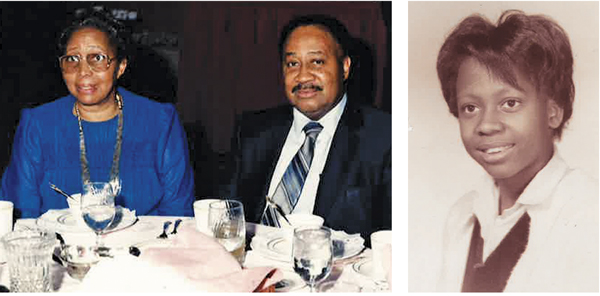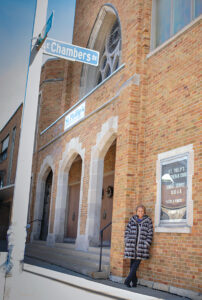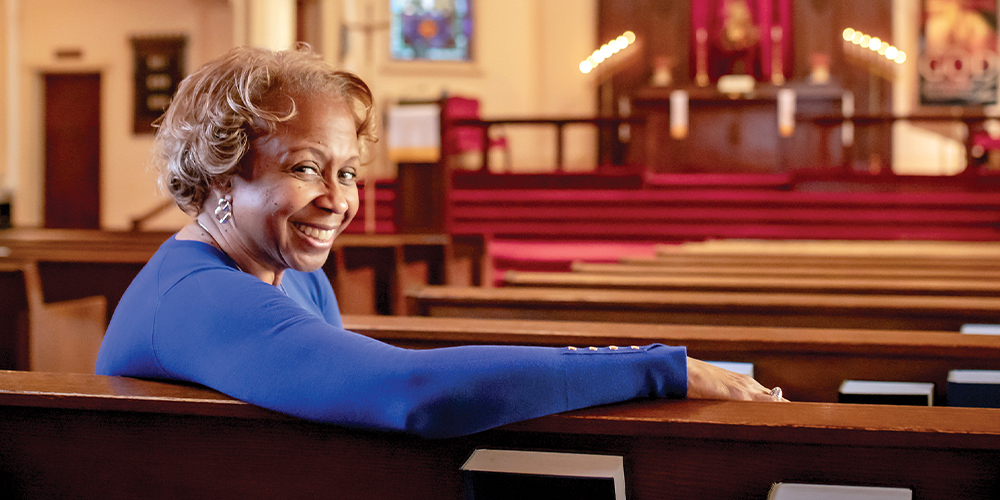 |
A woman lives her faith from Milwaukee’s central city to the halls of the United Nations.
Dr. Joan Prince, a lifelong member of St. Philip, Milwaukee, Wis., has had a life and career of many “firsts.” Despite all the challenges that she has faced as a black woman breaking barriers in her education and career, she remains optimistic for her synod’s future and joyful for the incredible life that God has given her.
Humble beginnings
The youngest of four siblings, Joan was raised in a changing neighborhood of Milwaukee in the era of the Civil Rights movement. Despite growing up in one of Milwaukee’s poorest neighborhoods, Joan became an heir of immeasurable riches at her baptism as a toddler. Throughout her life, she has always been richly blessed to know Christ as her Savior. Her faith—born in her baptismal grace and nurtured by the gospel—has given her life direction, guidance, stability, and purpose.
Her parents, who both worked at a factory, were early members of St. Philip Lutheran Church, which was launched as a mission to Milwaukee’s African-American community. Her father cared deeply about his children’s education and their faith development. So when a representative from Wisconsin Lutheran High School in Milwaukee invited parents to enroll their children at the new high school with a promise of tuition assistance, her father insisted that Joan and her siblings attend.
Facing challenges
A handful of African-American students from the church broke the school’s color barrier. The first challenge was just getting across town to the school. None of the parents had a car, which meant leaving daily at 6 a.m. for a 90-minute bus ride each way. From the drop off point, the students still had to walk three-and-a-half blocks. For their safety, they walked together in a group. Joan recalls, “That wasn’t a comfortable walk. We had other kids call us names. We had rocks thrown at us.”
These trailblazing African-American students faced challenges at school too. Not everyone was welcoming. But Christ gave them courage. As a freshman, Joan recalls an ink well being poured into her locker. Despite the harassment, on the final day of her first year, a popular girl, who had given her a very difficult time, apologized, gave her a hug, and expressed hope that she would return for her sophomore year. “Now 50 years later, she and I are still friends,” Joan reflects, as she marvels at what God can do through a common faith in Christ.
Breaking barriers
In 1971 at age 16, Joan graduated from high school with high honors. Although she wanted to go away to college, her father insisted that she stay close to home. She enrolled at the University of Wisconsin–Milwaukee and earned bachelor’s degrees in general studies and medical technology. She was the first African American to complete the school’s medical technology program, its clinical laboratory master’s program, and its doctoral degree program in medical science education.
Her professional career began as a medical technologist drawing blood and analyzing tests in the medical science labs of a five-hospital laboratory system. She was the first black woman ever hired there as a clinical supervisor. By 1988, she was running that lab as the supervisor in hematology. Although she recalls wonderfully receptive patients and coworkers, not every patient wanted a black woman to draw their blood. It was another opportunity to live her faith and follow her father’s advice: “Treat people the way you want them to treat you. And don’t judge people.”
After teaching at the University of Wisconsin Medical School for five years, Prince was named vice chancellor of the University of Wisconsin–Milwaukee in 2000, where she managed the university’s external relations program for more than two decades. The role of connecting authentically with others came naturally for Joan, who remarks, “I’ve gotten to let my light shine in relationships with people around the globe throughout my public career. I love bringing people together—building people up. My Savior’s love helps me understand people and care about everyone.”
One day in 2012, Joan got a phone call from the White House Office of Personnel. She hung up thinking it was a practical joke. It wasn’t. They called back. President Barack Obama wanted to meet with her. He asked her to serve as the citizen ambassador at the United Nations. “I was shocked—totally shocked—humbled, and honored to serve my country in that way,” says Prince. “When the president asks, it is hard to say no.”
At the United Nations, she found herself dealing with the competing interests of 190-plus other nations. Different cultures. Different ways of thinking. “My faith kept me going throughout that time,” she says. “There are very beautiful things about our world and very ugly things about our world. And I would always pray for strength to be objective—to be open—to never judge people until I knew the facts. And to do whatever I could to have a positive impact on God’s world. My faith helped me wherever I went.”

Faith during struggles

In January 2020, Joan was diagnosed with breast cancer. “I didn’t shed a tear. It all was in his hands.” Once again, she leaned on Jesus to keep her centered. Just before the COVID-19 pandemic stopped all but emergency procedures, she underwent surgery and then faced a series of radiation and chemotherapy treatments. By God’s grace, she is on the other side of her battle with cancer. God blessed the treatment, and she celebrated her three-year anniversary of being cancer-free.
Despite her physical healing, there are still old wounds of racism that rear their ugly head in her life. She explains that just a few months ago at a gas station in a suburb of Milwaukee after paying at the pump, she decided to go into the station to get a soda. “As I returned, there were two men standing by their car, and as I walked to my car, one of them says, ‘I am so sick of having these n*****s [n-word] invade wherever we go.’ ”
Rather than responding in anger or with words, she just sat for a time in her car. “I think there was ‘a Joan’ who earlier in life might have said something back,” she says. “But ‘this Joan’ knew that in order for them to see how wrong they were required me to act in a manner that might confuse them. That evening, I prayed for them that their souls could be cleansed from a hatred for people they didn’t even know.”
In all of life’s challenges, which Prince describes as a roller coaster, she keeps her Christian perspective. “It is easy to love God and to be happy and faithful when life is good. But I know that the roller coaster also will go down, and that’s where I pray hard for Christ to help me survive the downward spiral. But I know that God will bring me back up.”
Her faith keeps her centered and optimistic that the gospel can bring change and healing in our country one heart at a time. That’s what she sees as a role for Christians who embody God’s love. She has never seen herself as a victim. “It isn’t about returning hate with hate. It isn’t about being the victim. It is all about how do I look at myself through what Christ has said to me? And how do I go out to make the gospel-centered change that lasts forever?”
A picture of Jesus with his arms wide open hung in her office for 23 years. “That’s my favorite way to picture Christ—with him welcoming everyone,” Joan says. “That’s who Christ is. That’s why I love my multicultural congregation of St. Philip. Our arms are open like his. And I am optimistic about our synod’s future. I’d like to see our church consistently show that all people are welcome while providing help and connections to those who don’t know his love.”
It’s Christ’s inclusive love that keeps Dr. Joan Prince optimistic and hopefilled in him.
Learn more> Dr. Joan Prince and Rev. Dr. Kenneth Fisher presented together at last January’s WELS National Conference on Lutheran Leadership. View their presentation at lutheranleadership.com.
A significant beginning

St. Philip started as the result of surveys conducted by the Wisconsin and Missouri Synods in the 1930s and ’40s of the heavily populated area of Milwaukee’s inner city. In 1952, the Synodical Conference Mission Board decided to finance a new mission and its pastor, Missionary Bertram Sauer, who began a major canvassing effort on the north side of Milwaukee. The Jan. 8, 1953, issue of The Milwaukee Journal highlighted the significance of this new mission in an article entitled: “Lutherans here to open first interracial church: Main aim is to serve the 6th Ward’s Negro population; young pastor faces task.”
The article (taking up half of page 2 of the paper) reported: “[Bertram Sauer’s] task is big, for he has been assigned to build a Lutheran church among people who have almost no Lutheran background. . . . But Mr. Sauer believes the job must, and can, be done. The Lutheran church is not just for the Germans and Scandinavians who were born into it, he believes. . . . The church today has an obligation to carry the gospel to all people, regardless of race or nationality, he said.”
By 1955, when the congregation was officially organized under the name of St. Philip, about 30 adults had been confirmed. From 1956 to 1959, the congregation grew considerably, with 60 adult confirmations and 62 baptisms during those years; by 1959, it had 205 baptized members. The congregation moved several times before settling into its current location on the corner of Chambers and Holton Streets. Its current membership totals 430, with about 100 students in its elementary school and early childhood ministry.
Author: Kenneth Fisher
Volume 111, Number 1
Issue: January 2024
- My Christian life: A pastor with brain cancer finds true strength
- My Christian life: I have depression, but Jesus has me
- My Christian life: An unexpected call to ministry later in life
- My Christian life: Breaking barriers in Milwaukee and beyond
- My Christian life: Perspectives from a lay missionary
- My Christian life: One serviceman’s faith journey
- My Christian life: Navajo shepherdess finds joy in Jesus
- My Christian life: One woman’s gratitude for being excommunicated
- My Christian life: Making music as a family
- My Christian life: Engaging the church’s youth
- My Christian life: Leading as a Christian in the business world
- My Christian life: Fulfilling physical and spiritual needs
- My Christian life: Raising a child with special needs
- My Christian life: Premature twins defy medical odds
- My Christian life: College student recovers after rare diagnosis
- My Christian life: The reality of being a Vietnam veteran
- My Christian life: When vocation and ministry collide
- My Christian life: From Air Force sergeant to staff minister
- My Christian life: Faith provides firm foundation after cancer diagnosis
- My Christian life: From prospect to pastor
- My Christian life: The unique path of embryo adoption
- My Christian life: Turning tragedy into blessing
- My Christian life: A Malawian Christian committed to serving others
- My Christian life: Pen pal shares faith with prisoners
- My Christian life: Born deaf to a hearing family
- My Christian life: A single mother finds a new beginning
- My Christian life: Finding real Christmas joy while in the hospital
- My Christian life: Holding up the prophets’ hands
- My Christian life: One man’s battle with anxiety
- My Christian life: Heart transplant inspires a life of service
- My Christian life: Finding true peace through Psalm 23
- My Christian life: An incredible harp-playing journey
- My Christian life: Highlighting the Scriptures through art
- My Christian life: Serving in retirement as a vacancy pastor
- My Christian life: A man of truth
- My Christian life: The sign maker
- My Christian life: Once a detective, now a pastor
- My Christian life: A Ukrainian mother chooses life
- My Christian life: Teen faces difficult medical diagnosis
- My Christian life: Music as a companion on life’s journey
- My Christian life: WELS nurse lives out faith through her vocation
- My Christian life: A teacher retires full of memories
- My Christian life: On the front lines of a pandemic
- My Christian life: Dealing with mental illness
- My Christian life: Camp BASIC
- My Christian life: Battling cancer as a teenager
- My Christian life: Spencer Beach
- My Christian life: Mission opportunities in South Asia
- My Christian life: Haiti adoptions







